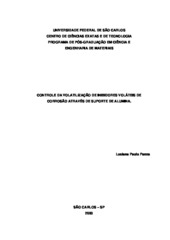Estudo da transição de fase sólido-vapor e da eficiência de inibidores voláteis de corrosão quando incorporados em matrizes poliméricas
Abstract
In this work it is proposed a potential barrier model between solid and vapor phases. As a consequence of this model it is developed a method to measure vapor pressure as low as 10-5 Pa. A thermodynamic system consisting of a cubic cavity with a small hole is considered (Knudsen cell). The cavity contains a sample, which the partial vapor pressure is desired to evaluate. The pressure in the cavity is proportional to the rate of mass effusion throughout the hole. The equations describing the vapor pressure as a function or the evaporation rate and the rate of mass effusion is developed. These quantities can be easily evaluated experimentally with small errors. This technique is applied to measure the vapor pressure of DICHAN , a commercial volatile corrosion inhibitor (VCI). The model for the vapor pressure requires a model for the phase transition interface between the solid and vapor states. It is assumed a potential barrier separating the vapor from the solid state. Comparing the results obtained in this work, with the vapor pressure obtained by other authors it can be evaluated the potential barrier as a function of the temperature Although VCIs have vapor pressure extremely small, this faint vapor gas is expected to be sensibly related to the efficiency against corrosion. It was studied the inhibitor behavior of an VCI commercialized in Brazil, which vapor pressure and molecular weight are unknown. This inhibitor differs from DICHAN for being free from nitrite ion and its lower cost. So, this study has two main objectives: first, its scientific contribution, with the development of a new method to obtain the vapor pressure of volatile solids; second, the development of a new commercial VCI.
